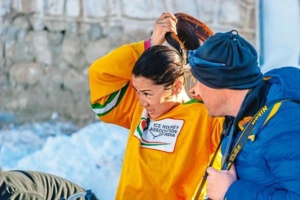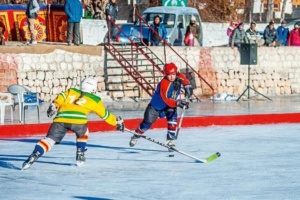It’s a three-month sport in Ladakh and neighbouring Kargil, at a time, most locals flee these freezing climes. A few young girls braved the chill and the odds to chase a sport that only the boys played until then. Today, they are a part of the Indian national ice hockey team.

First published:
https://www.livemint.com/Leisure/E1Ig4G8VGOjb0q0h6o0y2I/Fire-on-ice.html
Fire on ice
The first women’s ice-hockey side from India will make its debut at an international competition in March
The puffy jersey and oversized helmet belies Kunzes Angmo’s petite frame. It’s an aberration of sorts when you meet her off the ice, and once the hooter blows, it’s down to business. She sails past the opposition, twisting and turning gracefully, leaving sinuous trails on the ice in her wake. Then a stick check has her crashing. The crowd jeers. Kunzes recovers quickly. She adjusts her helmet and begins chasing the puck.
When the game comes to an end, Kunzes’ side, Jammu and Kashmir (Red), have sealed another win in the group stage of the Senior National Ice Hockey Championship. She walks off the ice and begins the elaborate process of undoing the bulky equipment. She carefully packs away the helmet and chest guard before handing it over to someone waiting in the crowd. The rest of the gear is tucked into her bag, and she takes off her sunglasses, wraps a pink scarf around her neck and walks out of the arena.
Like her teammates, Kunzes travels up to Leh in winter, when even the locals of the high-altitude city—it’s more than 11,500ft above sea level—scuttle away to escape the freeze. But winter is when the reservoir at Karzoo, which feeds the neighbouring fields in summer, provides a solid sheet of ice. It’s perfect for ice hockey, a sport that is little known in India and played by only a handful of new enthusiasts.
The poplar trees around the area are barren, and there’s black ice on the streets in places where the sun fails to reach. Spectators swarm the arena, the vapour trail of their breath adding to the frosty setting in the shadow of the Leh Palace.
Kunzes, 25, has taken a month off from her job at the Delhi Public School, where she teaches skating, while two of her teammates—Jigmet Angmo (20) and Diskit Angmo (19)—have taken a break from their college studies in New Delhi, much to the dismay of their families. They have been doing this every December since 2012. For them, ice hockey is what gully cricket is for the rest of the country. “We simply book our tickets, land up in Leh and get ready to face our parents,” Kunzes says with a grin.
They play simply for the love of the game, with no rewards to show, other than a medal after winning the nationals. But this time, there is something more. The current tournament is a selection trial for the first Indian women’s national side, which will make its debut in March at the IIHF Ice Hockey Women’s Challenge Cup of Asia Division 1 in Chinese Taipei. It’s hardly cause for celebration yet, though.
The Indian Army has had a tradition of playing ice hockey since the late 1970s, with men’s teams such as the Ladakh Scouts Regimental Centre and the Indo-Tibetan Border Police comprising players from the Ladakh region. It’s little surprise then that they are in a majority in the men’s national squad. Over the years, the men’s team has been funded by the defence establishment, while also receiving equipment from well-wishers such as the Canadian high commission. But the women have had no such aid and have always had to wait for their turn, or, as Diskit says, use jugaad, improvising each time they want to take to the ice.
“We used to look out for advertisements when the army was discarding their equipment,” says Diskit.
“I’ve even chased cars that had flyers at the back for second-hand equipment to get the contact number of the concerned person,” adds Jigmet.

The Ladakh Winter Sports Club—an initiative run by a group of friends who canvas for donations for the sport and organize tournaments with the help of the Ladakh Autonomous Hill Development Council, Leh (LAHDC)—has supported the girls through their growing years. But they have outgrown the equipment, so just gearing up for the game is a task these days.
“We have to borrow equipment from the men, which means waiting until they’re done with practice,” says Kunzes, who comes from a family of ice-hockey enthusiasts. Her father works as a government driver and her mother with the non-profit Women’s Alliance of Ladakh. Both still skate whenever time allows.
“The boys get donations, but we simply have to wait. We formed the Ladakh Women Ice Hockey Foundation this year to train young girls and hope they don’t have to face the same situation in the future,” she says.
At the national tournament, most of the players are women and men who grew up on ice. Starting off with a simple race as toddlers, they take to figure skating and speed skating. But for others, such as Delhi’s Aashu Singh, ice hockey happened quite by chance. The 23-year-old stepped out on ice for the first time four years ago. Having been an in-line skater through his growing-up years, this new surface was as much a thrill as it was an experiment. Such was its allure that he took up a job at iSKATE—an artificial ice-skating facility in a mall in Gurgaon, near the Capital—to polish his skills.
A couple of years ago, he was spotted by some officials from the Canadian high commission, who used to hire the rink for a few games of ice hockey at the weekend. They offered him used equipment and Singh started training after mall hours. He even shifted to a correspondence course from Delhi University, to dedicate more time to training. In April, he made the cut for the men’s national team that went on to play the Challenge Cup of Asia in Kuwait.
How the team got there was an improbable feat in itself, with a crowd-funding campaign successfully raising Rs.20 lakh; the donors included industrialist Anand Mahindra. Add to that the venue for the camp, which was held in the same mall in Gurgaon. However, each time an international tournament comes up, it’s down to the players and the association to create a kitty—there is no regular sponsor yet.
It’s been tough to play the sport in the country right from the inception of the Ice Hockey Association of India in 2002. Harjinder Singh, its general secretary, has been associated with the sport since its affiliation with the International Ice Hockey Federation in 2008 and believes the lack of funding has affected its growth.
“To receive funding from the government, we need 75% affiliate member states, which is difficult at the moment. We had set up an artificial rink in Dehradun for the South Asian Winter Games in 2008. But with no caretaker or money to maintain it, it lies neglected at the moment,” he says.
The lack of infrastructure has made it a three-month sport in Ladakh—the winter months when it freezes over—despite a majority of the players coming from this region. Ironically, it’s the whipping boys of the tournament, such as Delhi and Maharashtra, who can train around the year, thanks to artificial rinks in malls. The association has a few plans in the pipeline to set up six artificial rinks around the country, though raising Rs.50 crore for each facility will be an uphill task.
India’s current head coach, Abdul Hakim Giri, however, says ice hockey has come a long way since his playing days, when they had to fix steel blades on their army ammunition boots. He believes things will only get better.
“The Canadian high commission helps us out each year, and the association is also importing equipment. We’ve approached local manufacturers, but they want bulk orders, which will happen soon,” Giri says. “For now, the focus should be on infrastructure, and we’re building sheds at various facilities where there is natural ice in order to extend the playing season, until we have our own artificial rinks. Yes, we dream of playing in the Olympics one day.”
Adam Sherlip’s Hockey Foundation (THF), too has been doing its bit for the sport at the grass roots for the last seven years. The Canadian, who has worked with the National Hockey League (NHL)—which features teams from the US and Canada and is considered the pinnacle of ice hockey—in the past, visited Ladakh in 2009 and decided to get into coaching. After working with local players, he went on to become the first head coach of the Indian national team. Every winter, THF sends volunteers and ships equipment. With a pair of gloves alone costing around Rs.3,500, THF’s aid is essential for the sport to grow until a fix is found.
Antoine Jouvet, a THF volunteer, first came to the country as a tourist four years ago. The Canadian has been returning every year since and has travelled to Delhi, Shimla, Kargil, Drass, Chushul and Durbuk to train children. “Of course, there’s great enthusiasm when it comes to the game. I’ve seen a major improvement in the past couple of years, especially among the girls,” he says. “We are grooming a few local youngsters, who can continue training the kids once we’re gone. I’m positive ice hockey has a future here—everything’s possible in India.”
The ice doesn’t last long in places such as Leh and Shimla these days owing to the changing climate, but the game still has tremendous potential in areas with extreme temperatures such as Drass, which has an ice-hockey culture and where it is possible to play the sport for almost five months, says Jouvet.
Meanwhile, the enthusiasm is palpable among the women. The players shortlisted for the national team—all 28 are from Ladakh—will go back to wrap up their commitments at work and college before making their way to the national camp in a Delhi mall. “There aren’t many international women’s teams playing ice hockey at the moment. It’s a plus point for us, and we hope to make the most of it. Besides, we have something to look forward to now—at least my parents won’t ask me to stop wasting time on the ice all day,” Kunzes says with a smile.